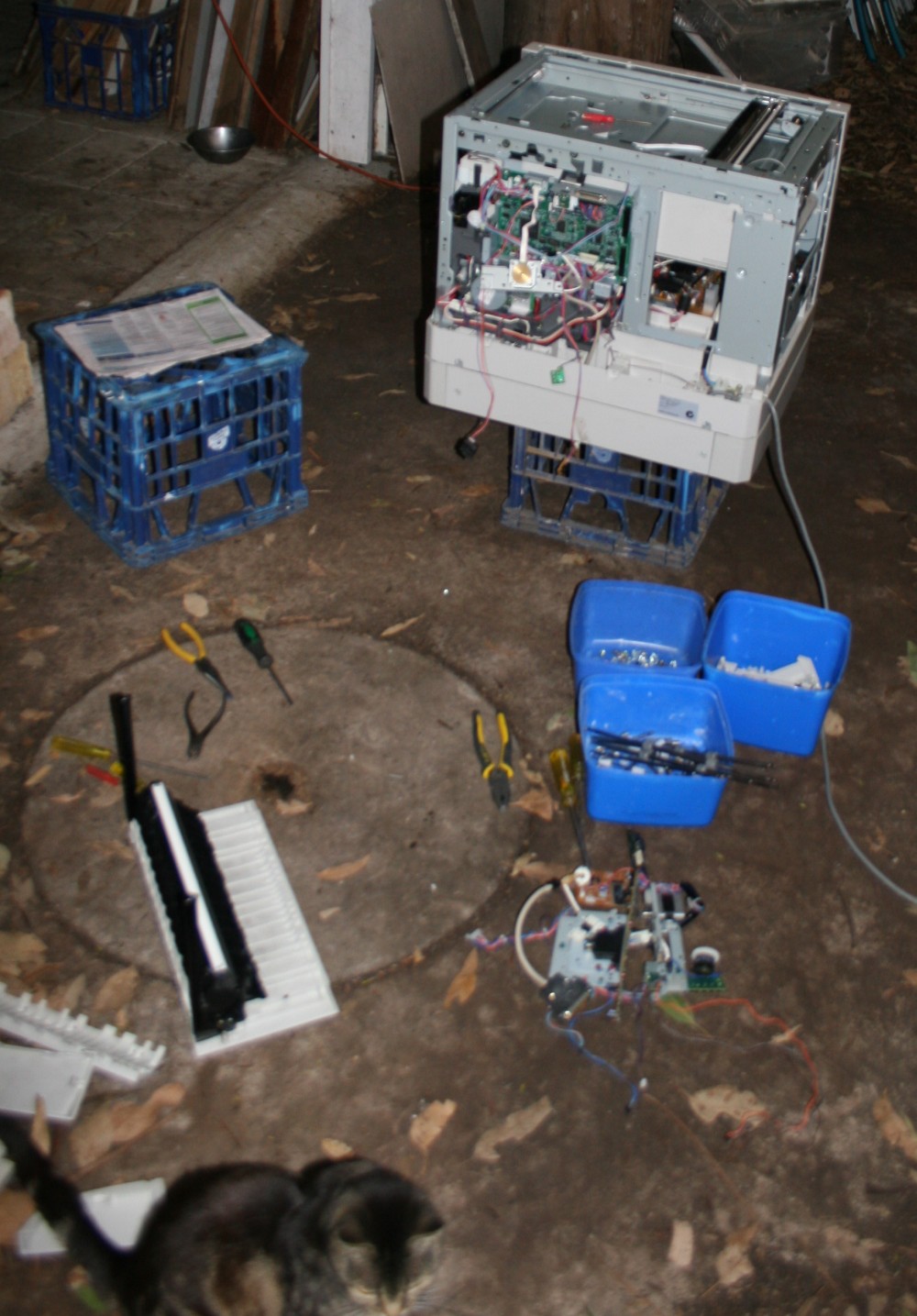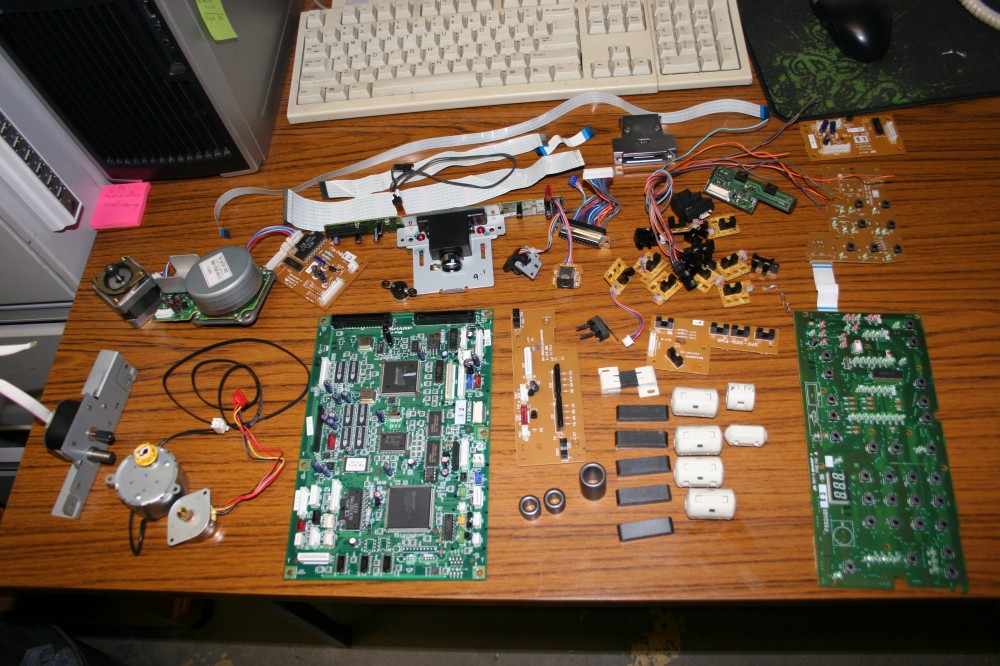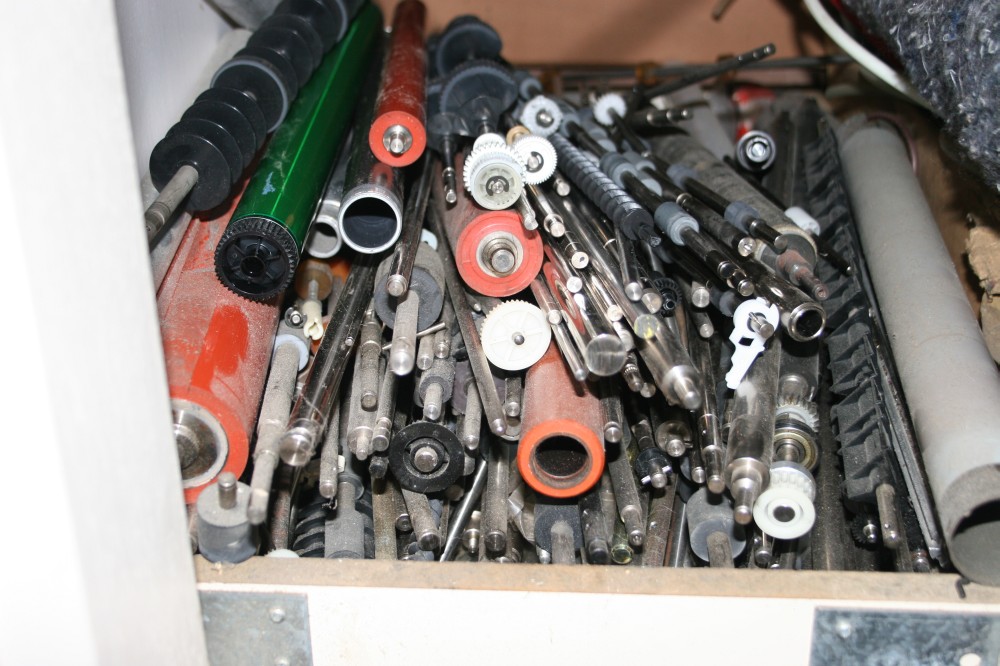
On Saturday morning I had a dentist appointment. Events could be summed up as 'not good news'. I'm at that stage of life when pretty much everything is downhill. Driving home a little depressed I spotted a tower-PC carcass beside the road, so stopped to pick it up. AMD Athlon, pre-SATA ports, DRAM gone, no HD. I'd have left it, except... I've always found a little therapeutic disassembly helps when I'm in a bad mood.
Back home I had a quick look inside the power supply before trying it to see if it's worth keeping, or stripping. Nope, it's had a sparky accident. (Can be seen in the pic.) And so, it became salvaged components.

That helped a bit, but really only an appetizer. Needed something with a bit more body to it. That would be you, Mr Digital Photocopier, that's been sitting around getting in the way for months. Another street tossed find, from last year. Since it was 'digital' (says so on the case) I'd picked it up in the hope it would contain a hard disk, and maybe worth keeping to use. An office-style unit, A4 + A3, and in nice condition. The previous owner had even put a sheet of plastic over it, to protect from rain. Which would suggest he thought it worked.

But no, it was an early form, digital scanning to memory then laser printing, but no HD storage, and incredibly no network connectivity either. Boy, what were they thinking? It worked more or less, but had that 'won't pick up paper reliably' problem copiers get once the tray pickup roller rubbers loses their necessary slight tackiness. There are ways to fix that, but really, I don't need the thing enough to be bothered taking it apart carefully to where I can get the rollers out, treat them, then put them back in. I'd looked on the net to see what the networking option cards cost, and no, there weren't any available for a few dollars, which is all I'd pay to make this into a usable printer/scanner/copier.
Incidentally, if anyone is interested, I have found in the past that soaking the rubber paper-pick-up rollers in tee-tree oil briefly seems to restore them to about the right tackyness. Maybe there are better ways; that's just one I found by trial and error experimenting.
Some 'death of a photocopier' photos:

It's Dusk. Both the time of day, and the cat's name.


Most of the electronic 'essence of photocopier.'

The chunkier bits.

The IR laser scanner, that forms an image onto the toner drum. Interesting, but would be more cool if the correction optics were glass, instead of cheap plastic.

This stuff (and the metal chassis parts) are destined for the recycling bin.

A few more polished steel rods and rollers, for the collection.
There's nothing in such units that I don't already have more than enough of, but this 'box of steel bars' (all printer and photocopier rods), is extremely useful when I need some nice polished steel or stainless rod. Which is quite frequently.
As you can see, I probably have enough of these for a while. So I should stop collecting junk like this photocopier.
But it's still interesting.
Disassembling appliances like this is something I've always enjoyed. Apart from the useful parts that result, it's fascinating to see the construction methods used, the electronics technology, and how they evolve over the years. There's also the lessons it teaches you about the planned obsolescence mindset of most companies that produce such things. They're not merely designed with little thought of long term use. They are virtually universally designed to not be repairable in any meaningful sense, and to be guaranteed to fail after a fairly limited lifetime.
For instance here's another disassembly example, from a few months ago, 20140212. This was an ink jet printer. It's a good illustration of why I refuse to own an ink jet printer.

It's not just the ridiculous amount of parts and materials involved, for a small desktop appliance.

Or the complexity. ('Essence of ink jet printer' here.)

It's this. Every ink jet printer contains a huge sponge down in the bottom area. Ink jet nozzles are inherently prone to clogging up with dried ink, dust, etc. To combat this (and make you buy more costly ink cartridges) such printers squirt a stupidly high proportion of the total ink in a cartridge into this sponge, as they clean the jets. It's squirt, wipe, squirt, wipe, etc.
The sponge in this photo is all saturated with ink. The original felt material forming the sponge is typically white, but goes black due to the mix of black, magenta, cyan and yellow ink soaked into it. A very disgusting sight, not least because of the probably hundreds of dollars of wasted ink it represents.
This one belonged to my mother. Discarded when she bought a new one. So it's personal. Screw you, ink jet printer makers.
Everyone should watch the documentary "The Light Bulb Conspiracy | planned obsolescence". 53 minutes. It's on youtube, but no point giving a link here as it's often taken down. They start with printers as an example.